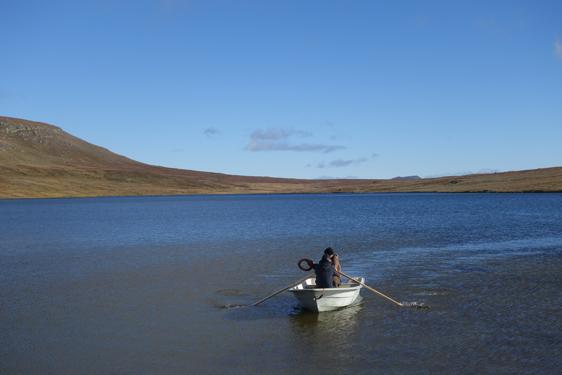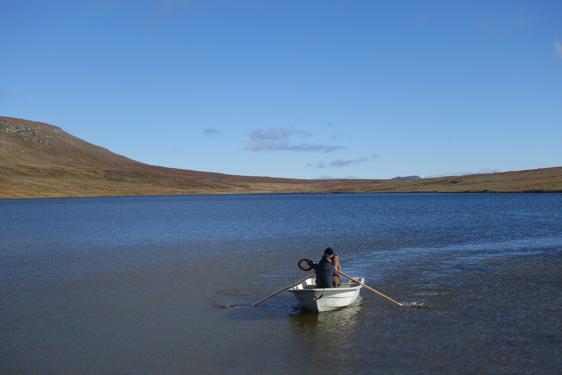
Credit: David Seekell
What is the volume of water in lakes on Earth? Using a mathematical analysis, researcher David Seekell, at Umeå University, and his American collaborators now suggest that the mean depth of lakes is 30 per cent lower than previously estimated. Shallower lakes implies less fresh water and has consequences for our understanding of climate change and the carbon cycle. The results have been published in Geophysical Research Letters.
"Our estimations measure around 190,000 km3, which is a very small amount of water. In comparison, the ocean contains 1.3 billion km3 of water. If we poured the water of all lakes on Earth together into one big lake, the mean depth of the lake would be 42 metres. The mean depth of the ocean is 3,682 metres," says David Seekell, associate professor at the Department of Ecology and Environmental Sciences and the Climate Impacts Research Centre (CIRC) at Umeå University in Sweden.
A possible conclusion is if lakes are shallower, they release more methane into the atmosphere than previously estimated.
Measuring the volume of the lakes on Earth seems like a simple task. Nevertheless, the challenges to carry out a measurement on a global scale are huge. Satellites can measure the volume of very large lakes, such as for instance Lake Vättern in Sweden or Lake Superior in the United States and Canada, but measuring the tens of millions of small lakes spread across the surface of the Earth requires time-consuming field work. A commonly used method is GPS positioning and depth sounder by boat. The researcher is required to row around on the lake until he or she has collected a large number of depths. The depths and coordinates are later used to build bathymetric maps which the volume and mean depth can be derived from. The approach works well for small lakes, but is expensive due to the time-consuming process and only a small number of lakes can be mapped.
So far, there have been few estimates of the volume of fresh water in lakes on Earth, and those that exist vary greatly and are typically presented without any data or methods.
"We decided to use a theory driven approach. We assumed that the surface of the Earth is self-affine. This basically means that if you zoomed in and out of a cross-section of the Earth's surface, the statistical characteristics of the vertical topography are predictable based upon a stretching factor," says David Seekell.
"We were able to use the model to estimate the mean volume of lakes at each given lake surface area, but also for variations in volume of lakes with the same surface area. Given the total lake surface area on Earth – which can actually be accurately recorded by satellite, even for small lakes – we were now able to estimate the total volume and assess the uncertainty in the estimate," says David Seekell.
The research team assessed that there are 184,000-199,000 km3 of lake water. The reason behind the variation can be explained by how lakes are counted and how their surface area is measured, particularly the smaller ones.
The majority of lake water can be found in a few very large lakes such as the Caspian Sea, Lake Superior, and Lake Baikal. In fact, about 80 percent of lake water can be found in the 20 largest lakes alone.
The quality and quantity of lake water can rapidly change due to human activities. For example, in some regions many ponds and reservoirs have been built for ornamental purposes, for irrigation, to generate electricity, or to store drinking water, which increasing the volume of fresh water.
On the other hand, some large lakes have dried up and disappeared. For example, Lake Poopo in Bolivia previously had a surface area of about 3,000 km2 and was one of the largest lakes in Bolivia. Due to climate change and water diversions for agricultural production, there is almost no water left, which greatly affects local communities. A very similar story can be told about the Aral Sea – once the fourth largest lake on Earth – where climate change and water diversions for agriculture have left only a tiny fraction of its former surface.
It is not only quantity that is of great concern at the moment. The water quality of the largest lakes on Earth are subject to degradation due to human activities. For example, Lake Erie in the United States and Canada with a surface area of about 25,667 km2 has been exposed to nutrient pollution and harmful algae blooms. This has rendered the lake an unreliable source for drinking water for communities along the shoreline. As a consequence, over 400,000 people even lost access to drinking water due to neurotoxins in the lake water associated with algae bloom in 2014.
"Our study emphasizes the relative scarcity of lake water, and how rapidly human activities can change the quality and quantity of water resources," says David Seekell.
###
Media Contact
Ingrid Söderbergh
[email protected]
46-706-040-334
@UmeaUniversity
http://www.umu.se/umu/index_eng.html
############
Story Source: Materials provided by Scienmag





